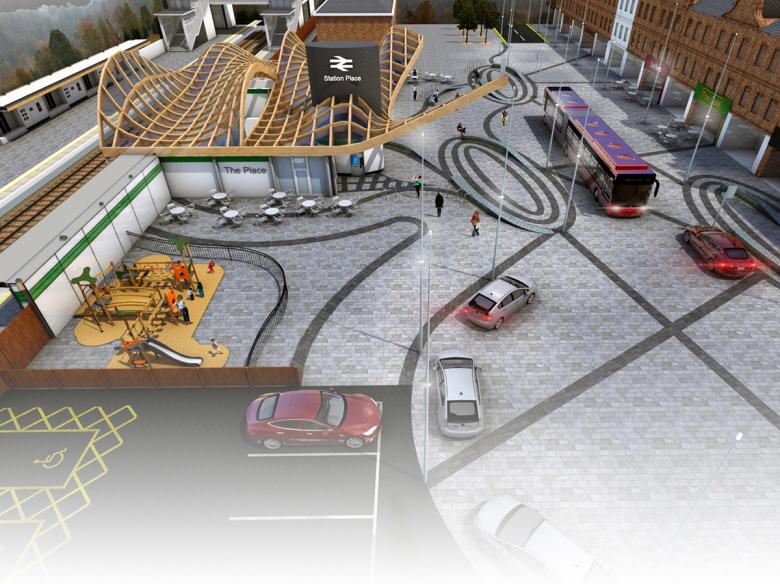BIM, Beers and BPR
The Vectorworks Design Summit 2017 took place in September in Baltimore, where World-Architects served as an Exclusive Media Partner and took in three days of keynotes, learning, and networking. Here we highlight a Vectorworks user: BPR Architects and one of its directors, Paul Beaty-Pownall, who spoke during the Summit about his firm's public projects in and around London.
At the beginning of his fifteen-minute presention as part of the opening keynote at the Vectorworks Design Summit 2017 in September, UK architect Paul Beaty-Pownall stated that "every image I’m going to show you has been created in Vectorworks." Such is the extent to which BPR Architects, which Beaty directs alongside Steve Cowell, has integrated Vectorworks into its day-to-day process: Photoshop is used to add some polish to the renderings, but everything else is done entirely in Vectorworks. He added, "We use Vectorworks as much as we can for our own benefit, for consistency, so we’re not juggling different types of software within the office."
The process by which the employee-owned practice based in Southwest London transitioned to using Vectorworks almost exclusively began in 2012, one year after the UK Government published its Construction Strategy (BIM Task Group) that would mandate BIM Level 2 by 2016. This was also a time when the firm, like many others, had downsized in response to the recession. BPR took the opportunity that the lull afforded to move the whole office from 2D to 3D starting with the 2012 release of Vectorworks and using one of the firm’s educational projects, Middlesex University (top photo), as a test case. This top-down decision was important in enabling BPR to pull off this fundamental, "cultural shift," as Beaty described it in his talk, from CAD (Computer-Aided Drafting) to BIM (Building Information Modeling), aided in no small part by the “BIM + Beers” sessions on Friday afternoons. And if Beaty saw someone in the office using, for instance, SketchUp, he would "lay down the law" and push them toward Vectorworks, in part because Vectorworks can do the same things SketchUp can do, but also to eliminate the work that would need to happen from redrawing it later in Vectorworks.
With eighty percent of BPR’s work in the public sphere — an even mix of rail and university projects, with the remaining fifth devoted to regeneration projects — moving to BIM was necessary for the firm’s survival within the BIM mandate. Specifically, the UK's BIM Task Group required collaborative 3D BIM on public projects by 2016 with the goal of "reducing capital cost and the carbon burden from the construction and operation of the built environment by 20%," per the Task Group's website. Beyond these commendable objectives, Beaty and BPR have grasped how BIM can help on the user side as well. As he states in his contribution to Jonathan Reeves’s 2015 book, Innovative Vectorworks BIM, "Savings during the design and construction phases only provide a small portion of the overall benefits of BIM compared to those available during the building’s use." One way the firm takes this into account is by dividing a project's data into zones that coordinate with how facilities management will operate. These zones might include the external envelope, the core, and the tenant fit-out, corresponding with how often materials and systems are replaced or modified over the lifespan of a building.
BIM, combined with IFC (Industry Foundation Classes, which enable models to be shared between users and across platforms), is a great collaborative tool that allows, among other practical considerations, architects and engineers to see if beams, ducts, and walls clash with each other. It can also streamline the production of an office like BPR, enabling it to tackle twice as much work now as it did twenty years ago with the same number of staff, something Beaty attested to in his morning talk. But for Beaty the most exciting aspect of BIM is the confidence it gives him to spend more time designing. As he worded it, BIM "enables you to use your imagination and have ideas, with the confidence that you know that if you implement those ideas in your 3D model all the 2D output and 3D images will keep up."
One area where BPR is confidently spending more time on design is a new vision for the Transport for London's Overground stations, which consists of such designs as West Hampstead, which Beaty presented during his talk, and Station Place, illustrated here. After carrying out research aimed at discovering the best route forward for these and other stations located predominantly in London's suburbs, where ridership is steadily increasing, Beaty concluded that station buildings aren't needed. Instead, as he told me after his morning presentation, "What you really need to do is open stations up and make them much more part of the neighborhoods they serve." With this fairly radical idea BPR envisioned the stations as streets open to the neighborhood, as with West Hampstead, or as a civic space with its own distinctive architecture, as with Station Place.
Uniting the rail, education and regeneration projects that make up BPR's output is a reliance upon 3D BIM for improving designs and adding value to the projects. A telling quote comes in Innovative Vectorworks BIM, where Beaty asserts that "BIM is as much a process of how we communicate as it is a method by which we prepare our design proposals." So by working primarily in Vectorworks, the BIM software becomes more than a tool for production: it is a way to work together, be it within BPR, with consultants, or with the client and the ever-important users.
World-Architects is an Exclusive Media Partner for the third annual Vectorworks Design Summit, which took place in Baltimore on September 18-20, 2017.





